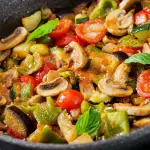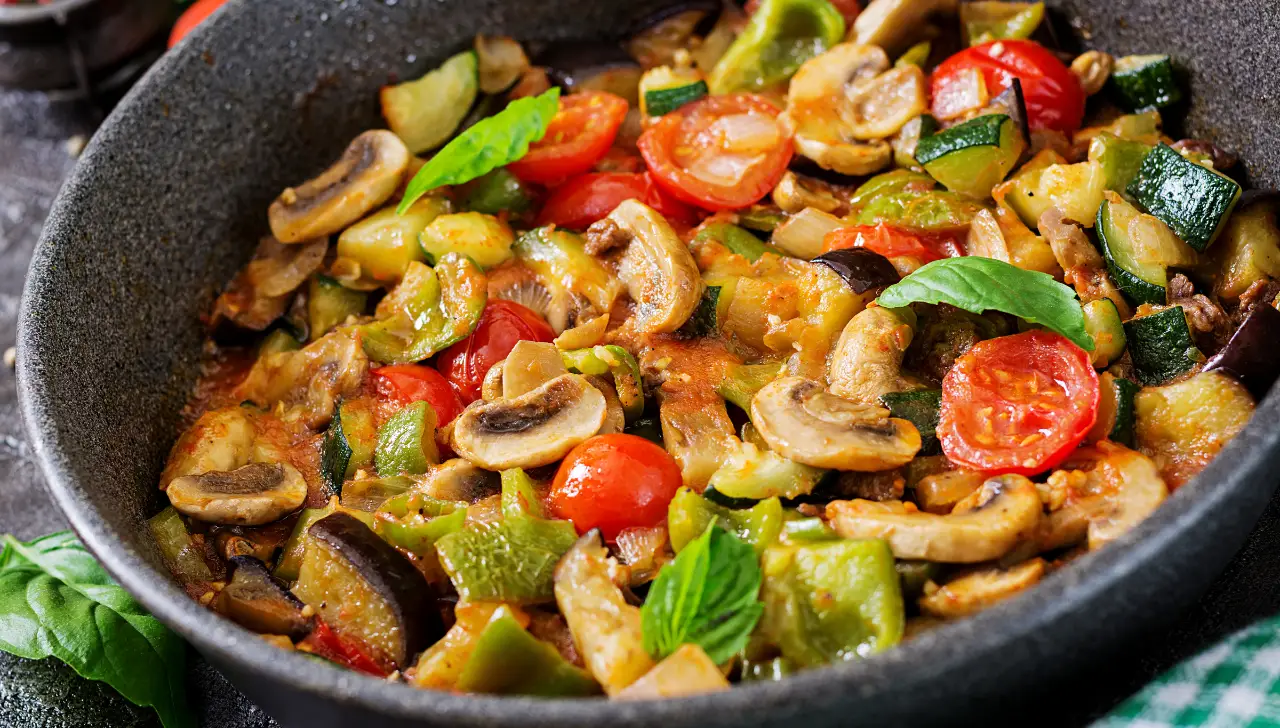Embarking on a journey into vegetarian cuisine can be both exciting and overwhelming, especially if you’re unsure where to begin. This comprehensive guide is designed to assist you in navigating the delightful and healthful world of vegetarian recipes. It offers a curated selection of dishes that are not only tantalizing to the taste buds but also packed with nutritional value. As you delve into the diverse array of plant-based meals, you’ll also gain insight into the myriad benefits associated with adopting a vegetarian lifestyle.
In recent years, the vegetarian movement has seen a remarkable surge in popularity. This shift is largely attributed to a growing awareness of personal health, environmental sustainability, and ethical concerns regarding animal welfare. As a result, plant-based diets have emerged as a prominent choice for many. This guide aims to provide a seamless starting point for those ready to explore the rich and varied flavors of vegetarian cooking, helping you to embark on this fulfilling culinary adventure with confidence and enthusiasm.
Find Vegetarian Recipes: A Beginner’s Guide
Welcome to your journey to find vegetarian recipes that suit every palate! Whether you’re exploring vegetarianism for health, ethical, or environmental reasons, this guide will be your trusted companion. As you navigate the vast world of plant-based dishes, you might want to explore diverse vegetarian recipes from around the world at My New Roots. We aim to help you find vegetarian recipes that are both delicious and easy to prepare. Let’s embark on this flavorful journey!
1. Basic Principles of Vegetarian Cooking
- Whole Foods: Focus on whole foods like fruits, vegetables, grains, nuts, and seeds.
- Protein Sources: Common vegetarian proteins include beans, lentils, tofu, tempeh, seitan, eggs, and dairy (for those who consume them).
- Flavor: Use herbs, spices, and condiments to enhance the natural flavors of your ingredients.
2. Essential Items for Your Vegetarian Pantry
- Grains: Quinoa, rice, oats, barley, and pasta.
- Legumes: Chickpeas, black beans, lentils, and kidney beans.
- Nuts & Seeds: Almonds, walnuts, chia seeds, and flaxseeds.
- Condiments: Soy sauce, tahini, olive oil, and nutritional yeast.
- Spices: Turmeric, cumin, paprika, and garlic powder.
3. Discovering Simple Vegetarian Recipes
1. Chickpea Salad
Ingredients:
- 1 can chickpeas, drained and rinsed
- 1 cucumber, diced
- 1 red bell pepper, diced
- 1/4 cup red onion, finely chopped
- 2 tbsp olive oil
- 1 tbsp lemon juice
- Salt and pepper to taste
- Fresh parsley, chopped (optional)
Instructions:
- In a large bowl, combine chickpeas, cucumber, bell pepper, and red onion.
- In a separate bowl, whisk together olive oil, lemon juice, salt, and pepper.
- Pour the dressing over the chickpea mixture and toss to coat.
- Garnish with fresh parsley before serving.
2. Lentil Soup

Lentils are not only delicious but also packed with nutrients. Dive deeper into the world of lentils at Lentils.org.
Ingredients:
- 1 cup dried lentils, rinsed
- 1 onion, chopped
- 2 carrots, diced
- 2 celery stalks, diced
- 4 cups vegetable broth
- 1 tsp cumin
- 1/2 tsp turmeric
- Salt and pepper to taste
- 2 tbsp olive oil
Instructions:
- In a large pot, heat olive oil over medium heat. Add onions, carrots, and celery. Sauté until onions are translucent.
- Add lentils, vegetable broth, cumin, turmeric, salt, and pepper.
- Bring to a boil, then reduce heat and simmer for 25-30 minutes or until lentils are tender.
- Adjust seasoning if needed and serve hot.
4. Tips for Successful Vegetarian Cooking
- Experiment: Don’t be afraid to try new ingredients or cooking methods.
- Plan Ahead: Meal planning can help ensure you have a balanced and varied diet.
- Stay Inspired: Follow vegetarian blogs, watch cooking shows, or join a vegetarian community to keep your meals exciting.
Related: Daily Harvest Pricing Guide: Cost-Effective Healthy Eating
Embracing vegetarianism can be a delightful culinary journey. With a focus on fresh, whole ingredients and a dash of creativity, you’ll discover a world of flavors and dishes that are both nourishing and delicious. Enjoy your journey and happy cooking!
Benefits of a Vegetarian Diet
When you decide to find vegetarian recipes and incorporate them into your diet, you’re not just treating your taste buds. A well-planned vegetarian diet offers a plethora of health, environmental, and ethical benefits. As you delve deeper into our guide to find vegetarian recipes, you’ll also discover the myriad advantages associated with plant-based eating.
1. Health Benefits:
- Heart Health: Vegetarian diets are often lower in saturated fats and cholesterol. This can help reduce the risk of heart disease.
- Lower Blood Pressure: Vegetarians often have lower blood pressure levels than non-vegetarians. This can be attributed to the higher intake of fruits, vegetables, and other plant-based foods.
- Reduced Risk of Chronic Diseases: A vegetarian diet can reduce the risk of certain diseases such as type 2 diabetes, certain cancers, and obesity.
- Better Digestion: High fiber content in plant-based diets can promote better digestion and regular bowel movements.
- Weight Management: Vegetarian diets are often lower in calories and fats, which can help in weight management.
- Nutrient-Rich: Vegetarian diets can be rich in essential nutrients like vitamins, minerals, and antioxidants, especially when they include a variety of fruits, vegetables, grains, and legumes.
2. Environmental Benefits:
- Reduced Carbon Footprint: Livestock farming is a significant contributor to greenhouse gas emissions. By opting for a vegetarian diet, one can reduce their carbon footprint.
- Conservation of Water: Producing plant-based foods generally requires less water compared to meat production.
- Reduced Land Use: Livestock farming requires vast amounts of land for grazing and feed production. A shift towards plant-based diets can help in conserving land.
- Lower Pollution: Livestock farming can lead to water pollution due to runoff from animal wastes, antibiotics, and hormones. A vegetarian diet contributes less to this form of pollution.
3. Ethical Benefits:
- Animal Welfare: Many people choose a vegetarian lifestyle to avoid contributing to the suffering of animals in factory farms.
- Sustainable Food Choices: A vegetarian diet can be seen as a more sustainable choice given the resource-intensive nature of meat production.
- Promotion of Biodiversity: Reducing the demand for meat can help in conserving habitats that might otherwise be converted to farmland, thus promoting biodiversity.
4. Economic Benefits:
- Cost-Effective: In many regions, plant-based foods like grains, legumes, and vegetables can be more affordable than meat, making a vegetarian diet cost-effective.
- Support for Local Farmers: Adopting a vegetarian diet can also promote support for local farmers who grow fruits, vegetables, and grains.
5. Personal and Spiritual Benefits:
- Mindfulness and Conscious Eating: Many people find that adopting a vegetarian diet makes them more mindful of their food choices and their connection to the environment.
- Spiritual Reasons: Some religious and spiritual traditions advocate for a vegetarian diet due to reasons of non-violence, purity, and respect for all living beings.
It’s important to note that while a vegetarian diet has many benefits, it’s essential to plan it well to ensure you’re getting all the necessary nutrients. Consulting with a nutritionist or dietitian can be beneficial, especially when transitioning to a vegetarian diet.
Popular Vegetarian Cuisines Around the World
As you continue to find vegetarian recipes, you’ll realize that vegetarianism isn’t just a modern trend. Many cultures around the world have a rich history of vegetarian or predominantly plant-based diets. Our guide will help you find vegetarian recipes from various global cuisines. Here’s a look at some popular vegetarian cuisines from various regions:
1. Indian
India has one of the world’s oldest and most diverse vegetarian traditions, thanks to religious beliefs and practices.
- Dishes: Samosas, dosas, vegetable curries, dal (lentil soup), paneer (cheese) dishes, and a variety of bread like naan and roti.
- Spices: Turmeric, cumin, coriander, cardamom, and garam masala.
2. Mediterranean
The Mediterranean diet emphasizes fresh fruits, vegetables, grains, and olive oil, with moderate amounts of dairy and limited meat.
- Dishes: Greek salads, falafel, hummus, ratatouille, and pasta with vegetable-based sauces.
- Flavors: Olive oil, garlic, oregano, basil, and rosemary.
3. East Asian (Chinese, Japanese, Korean)
While these cuisines do include meat, they also have a rich variety of vegetarian dishes.
- Dishes: Vegetable stir-fries, tofu dishes (like mapo tofu or agedashi tofu), vegetable sushi rolls, and bibimbap without meat.
- Flavors: Soy sauce, ginger, garlic, sesame oil, and seaweed.
4. Thai
Thai cuisine is known for its aromatic spices and herbs, with many dishes easily made vegetarian.
- Dishes: Green curry with vegetables, pad thai without shrimp or chicken, and tom yum soup (without shrimp).
- Flavors: Lemongrass, galangal, kaffir lime leaves, and coconut milk.
5. Middle Eastern
Rich in grains, vegetables, and legumes, Middle Eastern cuisine offers a plethora of vegetarian options.
- Dishes: Falafel, tabbouleh, baba ganoush, and stuffed grape leaves.
- Flavors: Sumac, za’atar, tahini, and pomegranate molasses.
6. Mexican
Traditional Mexican cuisine, apart from its famous meats, has a wide range of vegetarian dishes.
- Dishes: Vegetable tacos, bean burritos, chiles rellenos (stuffed peppers), and guacamole.
- Flavors: Cilantro, lime, chili peppers, and cumin.
7. Ethiopian
Ethiopian Orthodox Christians observe many fasting days, during which they eat vegan meals, leading to a rich tradition of plant-based dishes.
- Dishes: Injera (spongy bread) served with various vegetable stews like misir wat (lentil stew) and shiro wat (chickpea stew).
- Flavors: Berbere spice mix, cardamom, and fenugreek.
8. Italian
Beyond the pizzas and pastas, Italian cuisine has a variety of vegetarian dishes that celebrate fresh produce.
- Dishes: Margherita pizza, eggplant parmigiana, risotto, and minestrone soup.
- Flavors: Basil, oregano, garlic, and olive oil.
These are just a few examples, and within each cuisine, regional variations offer even more diversity. Exploring vegetarian dishes from around the world can be a delightful way to experience global cultures and flavors.
Transitioning to a Vegetarian Diet
Making the switch to a vegetarian diet can be a transformative experience for your health, the environment, and your culinary adventures. However, it’s essential to approach this transition thoughtfully to ensure you’re getting all the necessary nutrients and enjoying the process. Here’s a guide to help you navigate this change:
1. Understand Your Motivation
Before diving in, reflect on why you want to adopt a vegetarian lifestyle. Whether it’s for health reasons, ethical concerns, environmental considerations, or simply a love for plant-based foods, knowing your motivation will help you stay committed.
2. Start Slowly
If you’re used to a diet heavy in meat, it might be beneficial to transition gradually:
- Week 1-2: Dedicate specific days of the week as “meatless days.”
- Week 3-4: Increase the number of meatless days or eliminate one type of meat (e.g., red meat) entirely.
- Continue: Gradually increase your meatless days until you’ve fully transitioned.
3. Educate Yourself
Understanding nutrition will help ensure you’re getting a balanced diet:
- Protein: Sources include lentils, beans, tofu, tempeh, seitan, nuts, seeds, and dairy (if you’re not vegan).
- Iron: Spinach, lentils, chickpeas, quinoa, and fortified cereals are excellent sources. Pair them with vitamin C-rich foods to enhance absorption.
- Calcium: Leafy greens, fortified plant milks, almonds, and sesame seeds are good sources.
- B12: This is mainly found in animal products, so consider fortified foods or supplements.
4. Plan Your Meals
Meal planning can help ensure variety and nutritional balance. It also makes grocery shopping more straightforward and can reduce food waste.
5. Explore New Foods and Cuisines
A vegetarian diet can introduce you to a world of flavors and dishes:
- Experiment with new vegetables, grains, and legumes.
- Try vegetarian dishes from global cuisines like Indian, Mediterranean, or Thai.
6. Learn to Cook
Being able to prepare your meals can be empowering and ensures you know exactly what’s in your food. There are countless vegetarian cookbooks and online resources available.
7. Listen to Your Body
Pay attention to how you feel. If you’re constantly tired, hungry, or unsatisfied, you might need to adjust your diet. Consider consulting a nutritionist or dietitian who can provide personalized advice.
8. Be Prepared When Eating Out
- Research restaurants in advance to find vegetarian-friendly options.
- Don’t hesitate to ask the staff to modify dishes to fit your dietary needs.
9. Find a Support System
Joining vegetarian or vegan groups, both online and offline, can provide support, share experiences, and offer recipe ideas.
10. Be Kind to Yourself
Transitioning to a new diet can come with challenges. If you slip up, don’t be too hard on yourself. Remember your motivation and keep moving forward.
Transitioning to a vegetarian diet can be a rewarding journey. With a little planning, education, and an open mind to new flavors, you can enjoy a diverse, nutritious, and delicious diet that aligns with your values and goals.
Vegetarian Meal Planning

When you’re on a quest to find vegetarian recipes, it’s crucial to ensure that your meals are balanced and provide all the necessary nutrients. This section will guide you through the process of vegetarian meal planning, making it easier for you to find vegetarian recipes that not only tantalize your taste buds but also nourish your body.
1. Understand Nutritional Needs:
Protein: While meat is a primary source of protein for many, vegetarians can obtain protein from sources like:
- Legumes (lentils, chickpeas, black beans)
- Tofu and tempeh
- Seitan (wheat gluten)
- Nuts and seeds (almonds, chia seeds, flaxseeds)
- Whole grains (quinoa, bulgur, barley)
- Dairy or dairy alternatives (soy milk, almond milk)
Iron: Plant-based iron is non-heme iron, which is less readily absorbed than the heme iron found in meat. Include foods like:
- Lentils, chickpeas, and beans
- Spinach and other leafy greens
- Fortified cereals
- Pumpkin seeds
- Dried fruits like apricots
- Pair these with vitamin C-rich foods (like bell peppers, tomatoes, citrus fruits) to enhance iron absorption.
Calcium: Essential for bone health, sources include:
- Dairy products or fortified dairy alternatives
- Leafy greens (kale, bok choy, collard greens)
- Almonds and tahini
- Fortified foods (like orange juice)
- Tofu set with calcium
Vitamin B12: As it’s primarily found in animal products, vegetarians should consider:
- Fortified cereals and plant milks
- Dairy products
- Nutritional yeast
- Supplements, if necessary
Omega-3 Fatty Acids: Important for brain and heart health, sources include:
- Flaxseeds, chia seeds, and hemp seeds
- Walnuts
- Algal oil supplements
Vitamin D: Besides sunlight, sources include:
- Fortified dairy or plant-based milks
- Fortified cereals
- Supplements, if necessary
2. Plan Your Meals:
Breakfast:
- Oatmeal topped with berries, chia seeds, and a splash of almond milk.
- Whole grain toast with avocado and a sprinkle of sesame seeds.
- Yogurt (dairy or plant-based) with granola and fruit.
Lunch:
- Chickpea salad with tomatoes, cucumbers, olives, and feta cheese.
- Lentil soup with whole grain bread.
- Quinoa salad with roasted vegetables and a tahini dressing.
Dinner:
- Stir-fried tofu with broccoli, bell peppers, and cashews served with brown rice.
- Vegetable curry with chickpeas served with naan or rice.
- Spaghetti with a tomato and lentil sauce, sprinkled with nutritional yeast.
Snacks:
- Hummus with carrot sticks or whole grain crackers.
- A handful of nuts and dried fruits.
- Smoothies with spinach, banana, flaxseed, and soy milk.
3. Prep in Advance:
- Cook grains and legumes in bulk and store them in the fridge.
- Chop vegetables for easy access.
- Prepare sauces or dressings and keep them in jars.
4. Stay Hydrated:
- Drink plenty of water throughout the day.
- Herbal teas and infused waters can also be refreshing.
5. Adjust Based on Your Needs:
- If you’re active, you might need more calories and protein.
- Pregnant or breastfeeding women, elderly individuals, and children might have specific nutritional needs.
6. Diversify Your Diet:
- Try new foods and recipes to ensure a wide range of nutrients and to keep meals exciting.
Remember, everyone’s needs are different, so it’s essential to listen to your body and adjust your diet accordingly. Consulting with a nutritionist or dietitian can provide personalized advice and recommendations.
Cooking Techniques for Vegetarian Dishes
Vegetarian cooking, like any culinary art, involves a variety of techniques to bring out the best flavors and textures from plant-based ingredients. Here are some essential cooking methods to master for delicious vegetarian dishes:
1. Sautéing
- Description: Cooking food quickly in a small amount of oil or butter over medium-high heat.
- Best for: Vegetables, tofu, tempeh, and mushrooms.
- Tips: Always heat the pan before adding oil. Once the oil is hot, add your ingredients. Stir frequently for even cooking.
2. Roasting
- Description: Cooking food in an oven at a high temperature, allowing the natural sugars in the food to caramelize and enhance flavors.
- Best for: Root vegetables, bell peppers, tomatoes, broccoli, and cauliflower.
- Tips: Toss vegetables in a bit of olive oil, salt, and any desired seasonings before roasting. Spread them in a single layer on a baking sheet for even cooking.
3. Steaming
- Description: Cooking food using the steam from boiling water.
- Best for: Green vegetables like broccoli, green beans, and spinach. Also good for dumplings and buns.
- Tips: Avoid over-steaming to maintain the vibrant color and nutrients of the vegetables.
4. Grilling
- Description: Cooking food on a grill over direct heat.
- Best for: Portobello mushrooms, bell peppers, zucchini, eggplant, and firm tofu.
- Tips: Brush vegetables and tofu with a marinade or oil to prevent sticking and enhance flavor.
5. Braising
- Description: Slow-cooking method that starts with a quick sear, followed by long simmering in a small amount of liquid.
- Best for: Tougher greens like collard greens or kale, as well as seitan or large cuts of tempeh.
- Tips: Use a flavorful liquid like vegetable broth, wine, or a mix of both.
6. Stir-Frying
- Description: A quick-cooking method using high heat and continuous stirring.
- Best for: Mixed vegetables, tofu, tempeh, and seitan.
- Tips: Use a wok or large frying pan. Cook ingredients in batches to ensure even cooking, and have all ingredients prepped before starting.
7. Blending
- Description: Pureeing ingredients to a smooth consistency.
- Best for: Soups, sauces, smoothies, and dips like hummus or guacamole.
- Tips: For hot soups, allow the mixture to cool slightly before blending to avoid splatters. Use a high-speed blender for creamiest results.
8. Marinating
- Description: Soaking foods in a seasoned liquid to infuse flavor.
- Best for: Tofu, tempeh, mushrooms, and vegetables before grilling or roasting.
- Tips: The longer you marinate, the deeper the flavor. However, avoid marinating too long, as some acidic marinades can make food mushy.
9. Baking
- Description: Cooking food by surrounding it with dry heat in an oven.
- Best for: Casseroles, quiches, pies, and baked goods.
- Tips: Always preheat the oven. Use a thermometer to ensure accurate temperatures.
10. Poaching
- Description: Cooking food gently in simmering liquid.
- Best for: Eggs and delicate vegetables.
- Tips: The liquid should be just below boiling. For added flavor, use broths or add herbs and spices to the water.
By mastering these techniques, you’ll be better equipped to find vegetarian recipes that cater to various tastes and preferences. Always remember the secret to exceptional vegetarian cooking lies in using fresh, premium ingredients and letting their inherent flavors take center stage.
Vegetarian Substitutes for Meat Lovers

For those who love the taste and texture of meat but are considering a vegetarian lifestyle, there are numerous substitutes available that can mimic the flavors and textures they’re accustomed to. Here are some popular vegetarian substitutes for meat lovers:
1. Tofu (Bean Curd):
- Texture: It can range from soft to extra-firm.
- Uses: Stir-fries, scrambles, grilling, baking, and soups.
- Tip: Marinating tofu can infuse it with flavors, making it a versatile substitute.
2. Tempeh:
- Texture: Firm and grainy.
- Uses: Stir-fries, sandwiches, salads, and grilling.
- Tip: Made from fermented soybeans, tempeh has a nutty flavor and can be sliced or crumbled.
3. Seitan (Wheat Gluten):
- Texture: Very meat-like, chewy.
- Uses: Stir-fries, sandwiches, stews, and even as a steak substitute.
- Tip: Seitan absorbs flavors well, so it’s great for marinating.
4. Jackfruit:
- Texture: Shredded meat consistency.
- Uses: Pulled “pork” sandwiches, tacos, curries.
- Tip: Young, unripe jackfruit is best for savory dishes. It takes on the flavor of whatever it’s cooked with.
5. Lentils:
- Texture: Soft when cooked.
- Uses: “Meat” sauces, shepherd’s pie, burgers, and meatloaf.
- Tip: They’re a great source of protein and can give a meaty texture to dishes.
6. Mushrooms (especially Portobello and Shiitake):
- Texture: Chewy and dense.
- Uses: Grilled mushroom caps as burgers, stir-fries, stews, and roasts.
- Tip: Mushrooms have a natural umami flavor, which is often associated with meat.
7. Eggplant:
- Texture: Soft and slightly chewy when cooked.
- Uses: Grilled, roasted, or in dishes like eggplant parmesan.
- Tip: It can be used as a steak substitute when sliced thickly and grilled.
8. Cauliflower:
- Texture: Varies depending on preparation.
- Uses: “Steaks”, buffalo “wings”, and as a ground meat substitute.
- Tip: When finely chopped and sautéed, it can resemble the texture of ground meat.
9. Beans and Chickpeas:
- Texture: Soft.
- Uses: Burgers, stews, salads, and tacos.
- Tip: Mashed beans can be used as a base for various “meat” patties.
10. Textured Vegetable Protein (TVP) and Soy Curls:
- Texture: Crumbly to chewy, depending on hydration.
- Uses: Tacos, stews, chili, and anywhere you’d use ground meat or shredded chicken.
- Tip: TVP is dehydrated soy, so it needs to be rehydrated before use. Soy curls are similar but come in larger pieces.
11. Ready-Made Vegetarian and Vegan “Meats”:
- Brands like Beyond Meat, Impossible Foods, Quorn, and others offer burgers, sausages, ground “meat”, and more made from plant-based ingredients.
- Tip: These are especially useful for those transitioning to a vegetarian diet as they closely mimic the taste and texture of meat.
When using these substitutes, the key is in the seasoning and preparation. Many of these alternatives can be made to taste quite similar to meat with the right spices, marinades, and cooking techniques.
Hosting a Vegetarian Dinner Party

Hosting a vegetarian dinner party can be a delightful experience, showcasing the diversity and richness of plant-based dishes. Here’s a guide to help you plan and execute a memorable vegetarian soirée:
1. Know Your Guests
- Dietary Restrictions: While you’re already avoiding meat, check if anyone has allergies, intolerances, or other dietary restrictions like veganism or gluten-free needs.
- Preferences: Some might not like certain vegetables or spices. It’s good to know in advance.
2. Plan a Balanced Menu
Aim for a mix of protein, grains, vegetables, and fats to ensure a satisfying meal:
- Starter: Soup (e.g., creamy tomato or lentil soup) or salad (e.g., mixed greens with roasted nuts and vinaigrette).
- Main Course: A protein-rich dish like a chickpea curry, stuffed bell peppers, or a tofu stir-fry.
- Side Dishes: Grilled vegetables, quinoa salad, or garlic bread.
- Dessert: Fruit tart, chocolate mousse (can be made vegan), or cheesecake.
3. Include Familiar Foods
While it’s great to introduce guests to new dishes, including a few familiar items can make everyone feel comfortable.
4. Offer a Variety of Textures and Flavors
A mix of crunchy, soft, spicy, sweet, and savory elements can make the meal more engaging and enjoyable.
5. Prepare in Advance
- Do Ahead: Dishes like casseroles, pies, or certain desserts can be made a day in advance.
- Set the Table: Lay out your dinnerware, glasses, and cutlery the night before.
6. Drinks
- Alcoholic: Offer a selection of wines, beers, or even a signature cocktail. Ensure they’re vegetarian (some alcoholic drinks use animal-derived fining agents).
- Non-Alcoholic: Herbal teas, mocktails, juices, or infused water.
7. Set the Ambiance
- Music: Create a playlist that sets a relaxed and welcoming mood.
- Lighting: Soft lighting, perhaps with candles, can create a warm atmosphere.
- Decor: Consider fresh flowers, decorative napkins, or themed centerpieces.
8. Cater to Different Appetites
Some guests might eat smaller portions, while others may have a heartier appetite. Prepare a bit extra to ensure everyone leaves satisfied.
9. Engage Your Guests
- Interactive Dishes: Consider dishes like build-your-own tacos, where guests can customize their fillings.
- Share Stories: Talk about the dishes, their origins, or any fun facts related to the ingredients.
10. Be Ready for Questions
Guests might be curious about vegetarianism, the dishes, or the ingredients. Embrace the opportunity to share and educate without being preachy.
11. Consider the Flow
If space allows, set up a buffet-style serving area. This allows guests to choose their portions and components, and it can be a conversation starter.
12. Enjoy Yourself
Remember, the goal is to have a good time and share delicious food. Don’t stress over perfection. Your enthusiasm and joy will be contagious!
Hosting a vegetarian dinner party is not just about the food; it’s about the experience, the conversations, and the memories created. When you set out to find vegetarian recipes for such an occasion, it’s essential to think beyond just the ingredients. With a bit of planning and creativity, you can offer a feast that not only delights the palate but might also inspire some guests to explore vegetarian dishes further. By sourcing the right recipes and adding your unique touch, you can transform a simple dinner into an unforgettable event.
FAQs
1. What is the best vegetarian dish in the world?
This is subjective and varies based on individual preferences and cultural influences. However, some universally acclaimed vegetarian dishes include:
- Paneer Tikka Masala (Indian): Grilled paneer cheese cubes in a creamy tomato sauce.
- Margherita Pizza (Italian): A simple pizza with tomato, mozzarella, basil, and olive oil.
- Falafel (Middle Eastern): Deep-fried balls made from ground chickpeas or fava beans, usually served in a pita or with tahini sauce.
2. What is the most popular vegetarian?
If you’re asking about the most popular vegetarian dish, it again varies by region. In the West, dishes like Vegetarian Lasagna, Veggie Burgers, and Salads (like Caesar or Greek without meat) are quite popular. In the East, dishes like Vegetable Biryani, Tofu Stir-Fry, and Vegetable Tempura are commonly enjoyed.
If you’re asking about famous vegetarians, notable names include Mahatma Gandhi, Paul McCartney, and Leonardo da Vinci, among many others.
3. What to order for dinner tonight vegetarian?
If you’re dining out or ordering in, here are some universally available and delicious vegetarian options:
- Pizza: Opt for a veggie-loaded pizza or a classic Margherita.
- Pasta: Dishes like spaghetti aglio e olio, fettuccine Alfredo, or penne arrabbiata.
- Asian Cuisine: Vegetable stir-fry, tofu dishes, or vegetable spring rolls.
- Mexican: Bean burritos, cheese quesadillas, or veggie fajitas.
- Indian: Palak paneer, chana masala, or vegetable korma.
4. What to make for dinner when you have nothing vegetarian?
When your pantry seems bare, there are still simple vegetarian dishes you can whip up:
- Spaghetti Aglio e Olio: Just spaghetti, garlic, red pepper flakes, and olive oil.
- Stir-Fried Rice: Use leftover rice, any veggies you have (like bell peppers, carrots, or frozen veggies), and soy sauce.
- Omelette or Scrambled Eggs: Add any veggies or cheese you have on hand.
- Grilled Cheese Sandwich: Bread and cheese are the basics, but you can add tomatoes, onions, or any leftover veggies.
- Soup: Use any leftover veggies, broth or water, and some basic seasonings. Blend if you prefer a creamy texture.
Conclusion
Embarking on a vegetarian journey can be an enriching experience. With the right resources, it becomes easier to find vegetarian recipes that not only tantalize your taste buds but also nourish your body. Embrace the world of plant-based cuisine and discover the myriad benefits it offers while continuing to find vegetarian recipes that align with your preferences.
📖 Recipe

Find Vegetarian Recipes
Ingredients
- 1 block firm tofu, pressed and cubed
- 2 cups mixed vegetables (broccoli, bell peppers, snap peas, etc.)
- 2 tbsp soy sauce
- 1 tbsp sesame oil
- 1 tsp ginger, minced
- 1 garlic clove, minced
Instructions
- Heat sesame oil in a large pan or wok over medium heat.
- Add tofu cubes and cook until golden brown on all sides.
- Add the mixed vegetables, ginger, and garlic. Stir-fry for 5-7 minutes or until vegetables are tender.
- Pour in soy sauce and stir well. Cook for another 2 minutes.
- Serve hot with rice or noodles.









